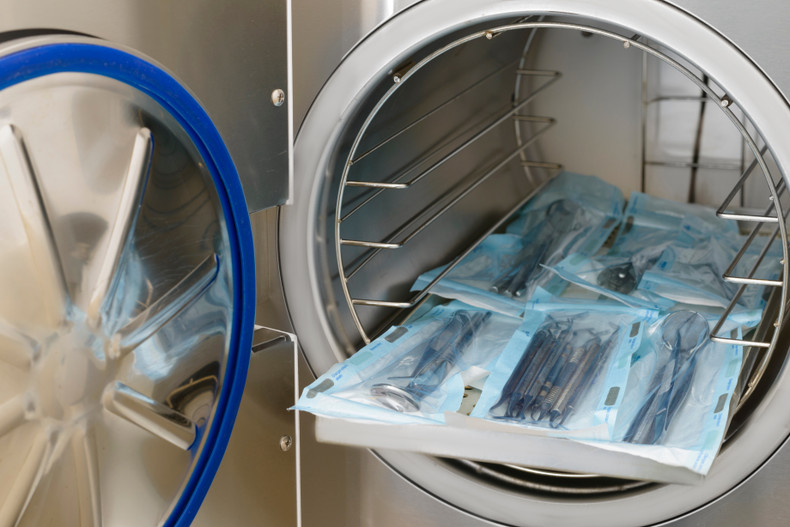
Sterile Processing professionals are keenly aware of the statement, “Follow the Manufacturer’s Instructions for Use (MIFUs).” But what happens when the IFU’s do not match the product we are using? Do we choose to follow the MIFU for the instrument, the product we use, or the MIFUs for the equipment? Usually, we are so laser-focused on the MIFUs for the instrument, that we may ignore the other MIFUs. If you have found yourself in this predicament, we would like to share some valuable solutions.
A single tray might contain items from as many as seventeen manufacturers; not to mention that each tray is subject to the MIFUs for the instrument spray, the enzymatic cleaner, the ultrasonic, the washer-disinfector, the instrument air, the magnified inspection light, the borescope, the instrument testing tools, the tray liners, the silicone mats, the instrument stringer, the internal chemical indicators, the towels or corner protectors, the rigid container or wrap, the tape or other external indicators, the labeling systems, and the pens used on the count sheet or the label. That is twenty-one additional MIFUs per tray. There is no mystery why this is confusing!
The first step in eating the MIFU conflict elephant is deciding which work to rule out. When reviewing MIFUs, many instructions do not match, or some that have process steps that are completely left out. A piece of advice we offer is that there is no conflict if your equipment cycle time exceeds the minimum cycle time stated by the product manufacturer of the product states or if no minimum time is stated on the product MIFUs.
Start the process of resolving MIFU conflicts by answering these questions:
- We have MIFU software, but do we have simple, easy-to-reference printed charts with the critical MIFUs for the products we use every day?
- We have a good idea of the instrument MIFUs, but are we familiar with the MIFUs of all of the packaging products we use?
- Are we involved in the Multidisciplinary Team and decision-making processes for the products we use in SPD or the implementation of new equipment and processes in the O.R.?
- Is anyone assigned to periodically review and update MIFUs in the log or the Instrument Tracking System?
RECOMMENDATIONS
To devise a plan of which IFU to use, the following references may help us to deduce the information provided or excluded from the manufacturer.
- ANSI/AAMI only addresses a conflict between sterilization cycle times and rigid containers, but the principles ring true for all MIFU conflicts. “Differences between the programmed cycle and the cycle parameters recommended by the device manufacturer should be investigated and, if possible, reconciled before the items are sterilized. If differing instructions cannot be resolved, the device manufacturer’s IFU should be followed.”
- The Centers for Medicare and Medicaid Services (CMS) states that we must have “Hospital policies that address steps to take when there are discrepancies between a device manufacturer’s instructions and equipment manufacturer’s instructions” and that “Where instructions conflict or are insufficient, the device manufacturer should be contacted for more information/guidance. If differing instructions cannot be resolved and the instrument is urgently needed, the device manufacturer’s instructions must be followed.”
SOLUTIONS
1. Implement a process and policy to review MIFUs annually and for pending product purchases and new instrument or Vendor-Loaned trays to ensure that you can properly process them. Identify someone to be responsible for this task and hold them accountable.
2. Change the parameters of your equipment when necessary and develop training and communication to address needed changes.
3. Contact the device and equipment manufacturers for any conflicts with items and request correspondence and documentation on any decisions on company letterhead. This can be filed in a binder available to all staff members.
4. Work with your Supply Chain to replace any products.
5. Use technology to protect you: Program into your Instrument Tracking System (ITS) all sterilization methods, cycle parameters, shelf-life expiration, etc.…
6. Print and post easy-reference charts with critical MIFUs for the products you use every day.
CONCLUSION
As professionals, we all know that MIFU compliance is the best way to protect our patients. We also know that not all MIFUs are created equal. It is up to us to take the extra step of reaching out to clarify instructions. These instructions should be constantly reviewed by leaders. A multidisciplinary team is an excellent place to discuss product, instrument, and equipment disagreements with stakeholders and take immediate action to resolve these issues. Full knowledge of the MIFUs in our department allows us to advocate for technology and equipment that ensures compliance.
This article was written by Jhmeid Billingslea CRCST CIS CHL CMRP CST, Managing Director Surgical Services, and Angela Llewelyn LPN CRCST CHL, Director of Development & Research, Advantage Support Services, Inc.
REFERENCES
Reprocessing medical devices in healthcare settings: validation methods and labeling guidance for industry and Food and Drug Administration staff. Document issued March 17, 2015.
ANSI/AAMI ST79:2017, Comprehensive guide to steam sterilization and sterility assurance in healthcare facilities. Association for the Advancement of Medical Instrumentation. Arlington, VA.
AAMI TIR12:2010, Designing, testing, and labeling reusable medical devices for reprocessing in healthcare facilities: a guide for device manufacturers. Association for the Advancement of Medical Instrumentation. Arlington, VA.
ANSI/AAMI ST81: 2004/(R)2010, Sterilization of medical devices—information to be provided by the manufacturer for the processing of resterilizable medical devices. Association for the Advancement of Medical Instrumentation. Arlington, VA.
Manufacturers Instructions for Use - Addressing Conflicts Amongst IFUs for Different Equipment and Products . posted March 17, 2021. https://www.jointcommission.org/standards/standard-faqs/home-care/leadership-ld/000002252/. Accessed 06/25/2021
Cleaning Instructions for Use: A Central Sterile Service Department Perspective. Susan Klacik. posted 2012.https://meridian.allenpress.com/bit/article/46/sp12/80/142436/Cleaning-Instructions-for-Use-A-Central-Sterile. Accessed 06/25/2021
Missing links in manufacturer instructions-for-use can lead to process kinks. Rick Dana Barlow. posted October 20, 2016. https://www.hpnonline.com/sterile-processing/article/13000341/missing-links-in-manufacturer-instructionsforuse-can-lead-to-process-kinks. Accessed 06/25/21

